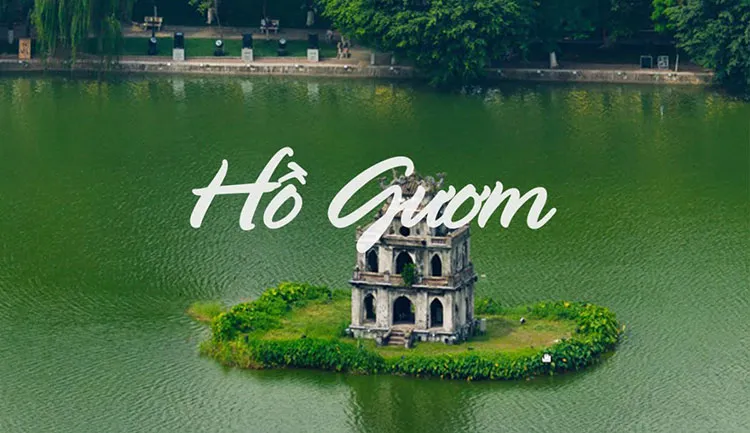Hoan Kiem Lake, the heart of Hanoi, is not only a scenic landmark but also a place imbued with mystical tales about the legendary turtle. The image of the golden turtle holding a sword has deeply embedded itself into the Vietnamese consciousness, symbolizing patriotism, justice, and the desire for peace. But between legends and reality, what is the truth about this unique turtle species?
The Turtle in Vietnamese Folklore
In East Asian culture, particularly in Vietnam, the turtle is revered as one of the “Four Sacred Creatures” (dragon, qilin, turtle, phoenix), representing longevity, strength, and wisdom. Unlike the other three mythical creatures that exist only in imagination, the turtle is a real animal, further solidifying its spiritual significance in people’s lives.
The turtle is seen as a balance between yin and yang, with its flat belly symbolizing the earth (yin) and its domed shell representing the sky (yang). The image of the turtle carrying a stele often conveys happiness, sustainable growth, and extraordinary resilience. The turtle is also a symbol of nobility, societal stability, and the enduring strength of the nation.

The image of turtles carrying doctoral steles at the Temple of Literature is a clear testament to the high regard Vietnamese dynasties held for the turtle as a symbol of endurance and intellect. From the legend of King Le Loi returning the sword to the golden turtle to the construction of doctoral steles on turtle backs, it is evident that the Le dynasty deeply valued this enduring and wise figure.
From Luc Thuy to the Legend of Hoan Kiem Lake
The story of the turtle dates back to the reign of King An Duong Vuong, where the deity Kim Quy helped the king build Co Loa Citadel and provided a turtle claw for a magical crossbow. However, the legend of the Hoan Kiem turtle is most famously tied to King Le Loi, who returned the divine sword to the golden turtle after defeating the Ming invaders.
According to legend, in early 1428, King Le Loi was boating on Luc Thuy Lake when a golden turtle emerged and approached his vessel. Le Loi recalled the sword “Thuan Thien,” which had been given to him by Le Thuan, and drew it out. The sword immediately flew toward the turtle, which seized it and dove to the bottom of the lake. From then on, Luc Thuy Lake was renamed Hoan Kiem Lake (“Lake of the Returned Sword”).
However, the exact origin of this legend remains uncertain. Does the tale of the turtle returning the sword relate to An Duong Vuong’s story as a lesson in trust and gratitude? Why was it a turtle and not another animal?
Historian Philippe Papan notes that the motif of a hero returning a sword to a turtle after repelling foreign invaders is not unique to Vietnam but is also widespread in other Southeast Asian countries.
Interestingly, no temples dedicated to King Le Thai To surround Hoan Kiem Lake, with only the village shrine of Kiem Ho worshipping Le Loi as the village guardian deity. It was not until 1897 that Governor-General Hoang Cao Khai commissioned the construction of a bronze statue of Le Loi on the lake’s shore.
During the later Le dynasty, Lord Trinh built the Five Dragon Pavilion and constructed a causeway that divided Luc Thuy Lake into two parts: Left View (Hoan Kiem Lake) and Right View. This raises the question: If the rare turtles only appeared in Hoan Kiem Lake, why were they absent in the southern Thang Long lakes (Ba Mau Lake, Bay Mau Lake) when they were once connected to the Right View portion of Luc Thuy Lake?
The Truth About Hoan Kiem Turtles
The turtles inhabiting Hoan Kiem Lake belong to the Rafetus swinhoei species, also known as the Hoan Kiem turtle, one of the rarest turtle species in the world. This is a large, soft-shell freshwater turtle species native to Vietnam and China.
The Hoan Kiem turtle can grow up to 2 meters in length and weigh over 200 kilograms. They have an incredibly long lifespan, living for hundreds of years. Their primary diet consists of fish, snails, and other aquatic animals.
Conservation of the Hoan Kiem turtle is an urgent task, as its global population is critically endangered. Scientists and conservation organizations are working tirelessly to research and implement measures to protect this rare species.
Conclusion
The legend of the Hoan Kiem turtle is an inseparable part of Vietnamese history and culture. While the reality of the Rafetus swinhoei turtle may differ from the legend, the symbolic value of the Hoan Kiem turtle remains intact. It represents peace, patriotism, and the hope for a better future. Protecting this rare turtle species is not only the responsibility of scientists but also of every Vietnamese citizen. Together, we must preserve this cultural icon so that the story of the Hoan Kiem turtle can be passed down to future generations.